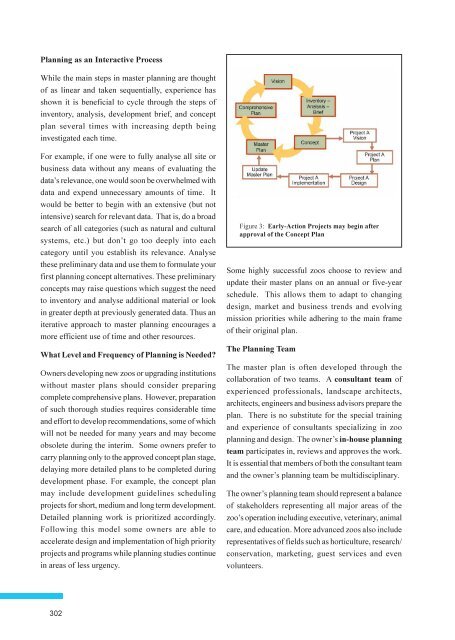Master Planning of Zoos - Central Zoo Authority
Master Planning of Zoos - Central Zoo Authority
Master Planning of Zoos - Central Zoo Authority
Create successful ePaper yourself
Turn your PDF publications into a flip-book with our unique Google optimized e-Paper software.
Technical Session VI<br />
<strong>Planning</strong> as an Interactive Process<br />
While the main steps in master planning are thought<br />
<strong>of</strong> as linear and taken sequentially, experience has<br />
shown it is beneficial to cycle through the steps <strong>of</strong><br />
inventory, analysis, development brief, and concept<br />
plan several times with increasing depth being<br />
investigated each time.<br />
For example, if one were to fully analyse all site or<br />
business data without any means <strong>of</strong> evaluating the<br />
data’s relevance, one would soon be overwhelmed with<br />
data and expend unnecessary amounts <strong>of</strong> time. It<br />
would be better to begin with an extensive (but not<br />
intensive) search for relevant data. That is, do a broad<br />
search <strong>of</strong> all categories (such as natural and cultural<br />
systems, etc.) but don’t go too deeply into each<br />
category until you establish its relevance. Analyse<br />
these preliminary data and use them to formulate your<br />
first planning concept alternatives. These preliminary<br />
concepts may raise questions which suggest the need<br />
to inventory and analyse additional material or look<br />
in greater depth at previously generated data. Thus an<br />
iterative approach to master planning encourages a<br />
more efficient use <strong>of</strong> time and other resources.<br />
What Level and Frequency <strong>of</strong> <strong>Planning</strong> is Needed?<br />
Owners developing new zoos or upgrading institutions<br />
without master plans should consider preparing<br />
complete comprehensive plans. However, preparation<br />
<strong>of</strong> such thorough studies requires considerable time<br />
and effort to develop recommendations, some <strong>of</strong> which<br />
will not be needed for many years and may become<br />
obsolete during the interim. Some owners prefer to<br />
carry planning only to the approved concept plan stage,<br />
delaying more detailed plans to be completed during<br />
development phase. For example, the concept plan<br />
may include development guidelines scheduling<br />
projects for short, medium and long term development.<br />
Detailed planning work is prioritized accordingly.<br />
Following this model some owners are able to<br />
accelerate design and implementation <strong>of</strong> high priority<br />
projects and programs while planning studies continue<br />
in areas <strong>of</strong> less urgency.<br />
302<br />
Figure 3: Early-Action Projects may begin after<br />
approval <strong>of</strong> the Concept Plan<br />
Some highly successful zoos choose to review and<br />
update their master plans on an annual or five-year<br />
schedule. This allows them to adapt to changing<br />
design, market and business trends and evolving<br />
mission priorities while adhering to the main frame<br />
<strong>of</strong> their original plan.<br />
The <strong>Planning</strong> Team<br />
The master plan is <strong>of</strong>ten developed through the<br />
collaboration <strong>of</strong> two teams. A consultant team <strong>of</strong><br />
experienced pr<strong>of</strong>essionals, landscape architects,<br />
architects, engineers and business advisors prepare the<br />
plan. There is no substitute for the special training<br />
and experience <strong>of</strong> consultants specializing in zoo<br />
planning and design. The owner’s in-house planning<br />
team participates in, reviews and approves the work.<br />
It is essential that members <strong>of</strong> both the consultant team<br />
and the owner’s planning team be multidisciplinary.<br />
The owner’s planning team should represent a balance<br />
<strong>of</strong> stakeholders representing all major areas <strong>of</strong> the<br />
zoo’s operation including executive, veterinary, animal<br />
care, and education. More advanced zoos also include<br />
representatives <strong>of</strong> fields such as horticulture, research/<br />
conservation, marketing, guest services and even<br />
volunteers.
















